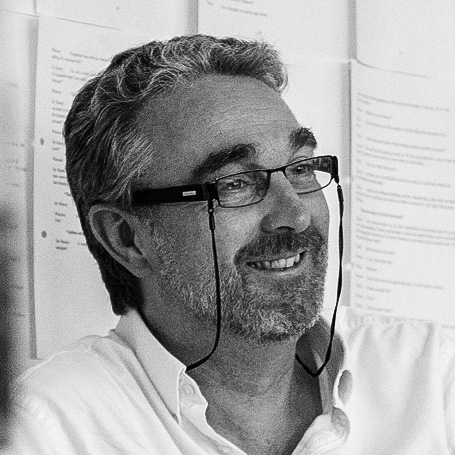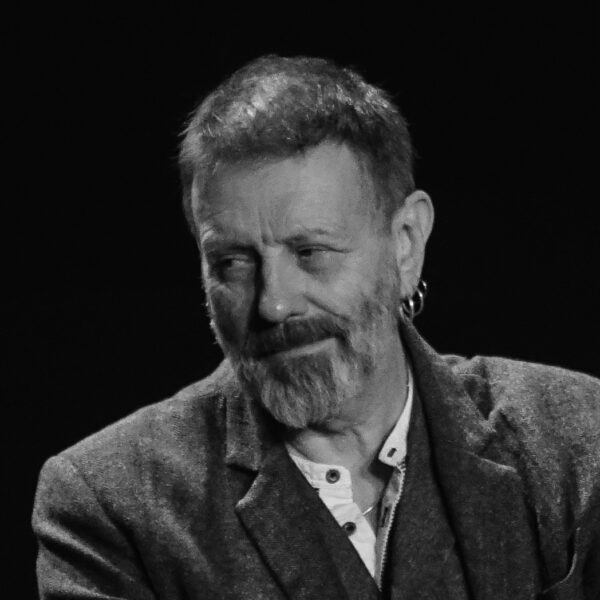In conversation: Damian Cruden and Mike Kenny
Director Damian Cruden and playwright Mike Kenny reflect on the eventful journey of their ambitious stage adaption of E Nesbit’s The Railway Children as the show returns to Yorkshire for Bradford 2025 UK City of Culture.

Published: July 14, 2025
In 2008, Cruden and Kenny’s adaption of The Railway Children first hit the stage at the National Railway Museum in York. It became a huge success, going on to be produced in London and Toronto and picking up an Olivier Award on the way.
As the show is adapted for Bradford 2025, the pair reflect on the long and eventful adventure of their stage production of The Railway Children.

Where did the idea for the show originally come from?
Damian Cruden (DC): When I went to my job interview [for Artistic Director] at York Theatre Royal in 1997, I was asked, ‘What would a season of work look like If I got the job? What kind of productions would I put on?’ And I said that I’d do The Railway Children at the National Railway Museum with a real train – not having any notion, really, of what that would be like. Then the idea sat for quite a long time when I got to York. There was too much other stuff to be done, and it had to be done before we got to the point where we would be able to do a big project like that.
What made you choose Mike as writer?
DC: Mike was known for his work with children and young people. He understands adaptation. He had been an actor, so he understands how to write for actors as well. And what I’ve always liked about Mike’s scripts is they’re kind of delightful pieces of art in themselves. He doesn’t write stage directions. He writes thoughts and suggestions and strange little prompts. Rather than somebody who’s trying to marshal something, he’s trying to leave room for everybody else in his writing. Mike has always enjoyed telling stories for children and young people, but he’s never done it in a way that was condescending to them. His work was always as good for an adult to listen to as for a child to listen to. It was always of high quality, never a step down. Some people might think that if you’re doing something for children, it’s got to be simpler. A, that’s wrong, and B, it’s not Mike. Actually, if you do something for children, it’s going to be more complicated, because they’ll catch you out…

And what did Damian bring to the collaboration as director?
Mike Kenny (MK): Damian just brings incredible enthusiasm. He really likes people, and he has more ideas than you can actually use. It was always a very sparky collaboration. I think we started collaborating before then and we went on collaborating on other things after that – but The Railway Children was thanks to Damian’s vision and energy. It’s nearly 20 years ago since you first put the show together.
Could you have imagined you’d still be talking about it?
DC: No, I don’t think so! I don’t think I had any idea of what it would be like to be nearly 20 years older – or if I’d make it, even!
MK: No, absolutely not. I mean, I’m saying that. Weirdly, though, as a project it had something that you don’t always get, which is it was just blessed from start to finish. It just worked. Although I would write things in the script like, ‘And then the train comes in’, I’m not sure I ever believed it was really going to happen. But it did, it absolutely did. I remember us all sitting there with our mouths open on the day the train first came in. It was amazing.
DC: Talk about standout moments in your life. I remember that first time we pushed the locomotive into the space and thinking: ‘Wow!’. I’ve never experienced anything like that. That’s special. There’s a famous actors’ saying about not working with children or animals.
Should trains be on that list too?
MK: Trains should be up there, absolutely – although, actually, I think trains are more obliging! They do what they’re supposed to. They’re designed to do what they do, and they work incredibly well.
DC: Yeah, trains are actually brilliant to work with. They’re beautiful. It’s been staged elsewhere over the years, but now the show is back on the Keighley & Worth Valley Railway.
Do Yorkshire and The Railway Children belong together?
MK: Absolutely, though the book wasn’t set in Yorkshire, and I’m not even sure Edith Nesbit ever came to Yorkshire! The movie brought it into Yorkshire.
DC: It’s a universal story. It sort of works anywhere – but the Yorkshire part of it, in a way, is very logical, because in terms of accents, it’s quite different from London. [Adopts best Yorkshire accent] ‘You’re not from round ’ere, are yer?’ A big part of the story is about how one community welcomes another community into its bosom and accepts it rather than just tolerates it. It learns from it. It’s about the dialogue of the exchange of people and strangers, and about how that’s phenomenally valuable for us. And of course, none of it’s a true story. It is absolutely made up, every part of it. There isn’t a main line from Oxenhope or from Oakworth to London King’s Cross. There never has been and there never would be, but it suits the story.
MK: When the old gentleman in it waves to the kids as he’s commuting off to London every day, apparently from the other side of Bradford – well, that commute was much more effective back in Victorian times than it is now. You’re not going to be able to get to London very fast from Keighley or Oakworth today.
Have you made many changes for this new production?
MK: We have made it more Bradford-friendly, perhaps. Essentially, in its heart, it is absolutely the same as it always was, but we have made a tweak and it’s one you can’t miss.
DC: We have changed it slightly – but fundamentally, the family still learn about themselves and learn about who they are. They learn about other people, they learn about what it is to be a human being and what it is to share. It’s still about that, and it will always be about that. We’ve got some great actors who are going to put a slightly different spin on it, but that’s about it. We’ve hardly changed any text at all. There are about four lines that have been changed.
What would you like audiences to take away from seeing the show?
MK: This isn’t so much to do with me – it’s there at the heart of the original story – but I would like them to take in the warmth of it. I think we’re living in even harder times now than when we first did it. We are in a time when we tend to demonise people from certain parts of society and I think we should be more welcoming. I would like people to take that on board.
DC: I think it would be nice for people to go home on the train and talk, rather than go home on the train on their phones. It would be nice for people to think about the advantages of accepting others for what they are, rather than tolerating others for what they are. And it’d be great if people went home and felt more positive about the future than they perhaps often do on a daily basis. I hope that they have a nice time in a space with a well-honed piece of theatre that is in some ways quite traditional, but in other ways like nothing they’ve ever seen. It relies on good acting, good writing, great sets and costumes, beautiful music, fantastic lighting and a strong ensemble of actors who play to the hilt. Add to that a journey on a steam engine there and back and you have magic.